-
Paper Information
- Next Paper
- Paper Submission
-
Journal Information
- About This Journal
- Editorial Board
- Current Issue
- Archive
- Author Guidelines
- Contact Us
International Journal of Modern Botany
p-ISSN: 2166-5206 e-ISSN: 2166-5214
2016; 6(1): 1-5
doi:10.5923/j.ijmb.20160601.01

Flora of Solanum rostratum Dunal. (Family-Solanaceae) in Libya: A New Record
Mohammed H. Mahklouf
Botany Department, Faculty of Science, Tripoli University, Tripoli, Libya
Correspondence to: Mohammed H. Mahklouf, Botany Department, Faculty of Science, Tripoli University, Tripoli, Libya.
| Email: |  |
Copyright © 2016 Scientific & Academic Publishing. All Rights Reserved.
This work is licensed under the Creative Commons Attribution International License (CC BY).
http://creativecommons.org/licenses/by/4.0/

A new invasive species, Solanum rostratum (Solanaceae) is reported for the first time for the flora of Libya. The specimens were collected from Gabes about 80 km east of Tobruk city in North East part of Libyan coast for two seasons 2013 – 2014, mophologiacal data were given to acertain its determination.
Keywords: Solanaceae, Solanum rostratum, Buffalobur nightshade , Invasive species
Cite this paper: Mohammed H. Mahklouf, Flora of Solanum rostratum Dunal. (Family-Solanaceae) in Libya: A New Record, International Journal of Modern Botany, Vol. 6 No. 1, 2016, pp. 1-5. doi: 10.5923/j.ijmb.20160601.01.
1. Introduction
- Solanum, with approximately 1500 species, is the largest genus in the family Solanaceae and one of the largest genera of flowering plants [1]. In general, Solanum flowers are easily recognized by their five-merous, radially symmetrical flowers with equal (isantherous) stamens that dehisce by terminal pores [2].Solanum rostratum Dunal. is an annual weed with strong ability for invasion. The species is native to the neotropics and southwestern United States, but it is now widely distributed throughout much of the world. S. rostratum is an occasional weed in open disturbed sites such as roadsides, waste dump sites, and overgrazed pastures. S. rostratum is an exotic noxious weed with potential harm, and has a strong capability of propagation and adaptation. As a kind of exotic poisonous weeds, it is toxic to the local crops and plants and has the potential to destroy the local ecological structure [3, 4] It exerts its influence on crops and pastures through competition for water, nutrients, and light throughout the growing season of the species. It is a nuisance because the sharp spines stick to skin, hair, and mucous membranes of livestock, and thus lower the quality of their skin and hair. Leaves, berries, and roots of S. rostratum contain cholinesterase inhibitory substances, which can cause livestock poisoning and even death. In addition, plant diseases and insect pests on the S. rostratum can also spread as the plant spreads [5, 6].Buffalobur is a native North American species, its range extending from central Mexico northward across the Great Plains of the United States. It is widely introduced elsewhere, including the U.S.S.R. and Australia. Repeatedly introduced into the Pacific Northwest, buffalobur usually appears in gardens, where it was planted with flower or vegetable seeds. Land managers found it near Penticton, British Columbia, following reseeding of rangeland. Occasionally, plants sold as tomato seedlings have matured into buffalobur. The name "buffalobur" dates back to the time of settlement of the Great Plains when the plant grew abundantly in the disturbed soil of buffalo wallows [7].In this paper Solanum rostratum is collected and recorded for the first time for the flora of Libya as an invasive weed in Cucurbita crop fields.
2. Materials and Methods
- Plant specimens were collected from Gabes about 80 Km east of Tobruk city in th North East part of Libyan coast (fig 6). Monitotoring the plant and gathering of plant specimens were conducted within two consecutive years between 2013 – 2014. The identification of the species was authenticated by Dr. Mohammed Mahklouf, Department of Botany, Faculty of Sciences, Tripoli University, with the aiding of data from the following literature [2, 5, 8-16]. A detailed taxonomic and morphologial description based on many field trips and collections within the two consecutive years 2013 – 2014 were done, then figures of the plant and locality are given here to facilitate its easy identification in the field. The present report represents the first record of Solanum rostratum in the flora of Libya.The plant specimens were deposited at the national herbarium of the Department of Botany, Faculty of Sciences, Tripoli University, Libya.Description of speciesSolanum rostratum Dunal., Hist. d. Solan. 234. 1813; et in DC. Prodr. 13, 1: 329. 1852; Fedch & Fler., Fl. Europ. Ross.: 842; Grossg., Fl. Kavk. 3: 355; Viznachn., Rosl. URSR: 370. Abrams., I11. Fl. Pacific. Stat. 3: 681, fig. 4503. 1951; Komarov et al., Fl. USSR. 22: 43.1955; Li in Fl. Liaoning. II: 273, pl. 123: 1, 2. 1992. ——Androcera rostrata Rydb. in Bull. Torr. Bot. Club. 33: 150. 1906. -lc.: Dun., tab. 24. 1813.; Gleason, “The New Britton &Brown”, F1. North. US & Canada. III: 200, fig. 1960. S. cornutum Lam., I11. 2: 25. 1793. Androcera lobata Nutt., Gen. Am. I: 129. 1818.Annual herbs, 20 - 60 cm tall, spreadinly branched, abundantly armed, covered with stipitate stellate and simple hairs intermixed with uneaqual yellow shap prickles, these sometimes more than 1 cm long on fruiting calyces. Leaves petiolate, alternate, elliptic to broadly ovate in outline, up to 12 cm long, deeply pinnatefed to pinnatisect near the base, the lobes irregular with rounded or obtuse apices; stellate-pubescent on both surfaces, prickly along main veins; petioles up to 8 cm long. Inflorescenses raceme-like monochasial cymes, to 15 cm long, 3 – 10 flowered; peduncles 1–4 cm long; pedicel to 1 cm long; calyx 5–12 mm long, the lobes laneolate, usually at least 2 times as long as the tube; corolla rotate, yellow, 15–25 mm in diam., stellate-pubescent on the outer surface, lobes short; stamens yellow, unequal; anthers 2 times longer than filaments, four of them nearly equal, the fifth much longer and curved above; style curved, equal to or exceeding the long anther. Fruits berry, globular, 9 –12 mm in diam, erect, closely invested by the densely prickly, accrescent calyx tube; seeds flattened, ovoid, dark brown, alveolate. (Fig 1, 2, 3, 4, 5)Fl. June – October.
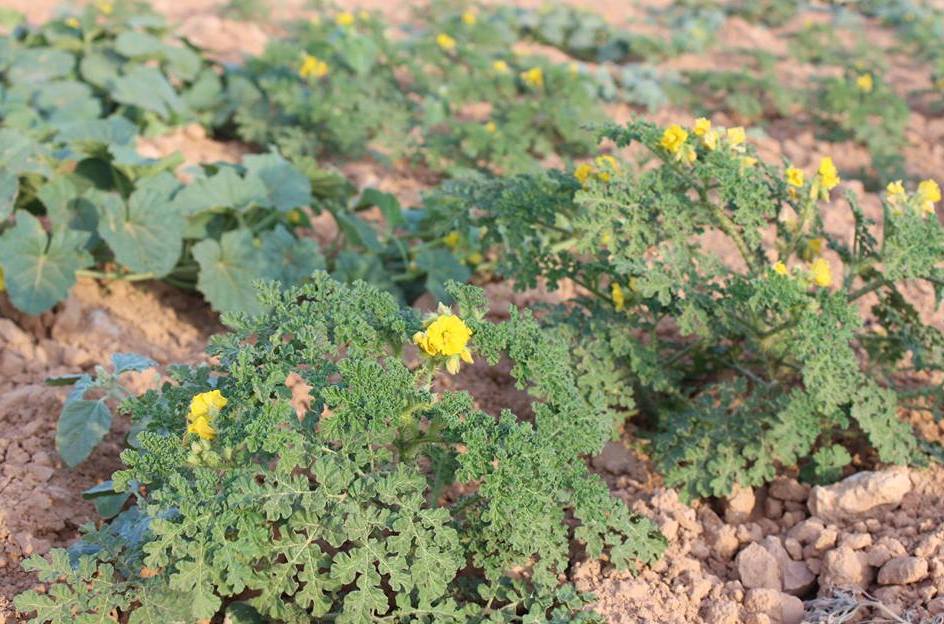 | Figure 1. Solanum rostratum in Cucurbita field |
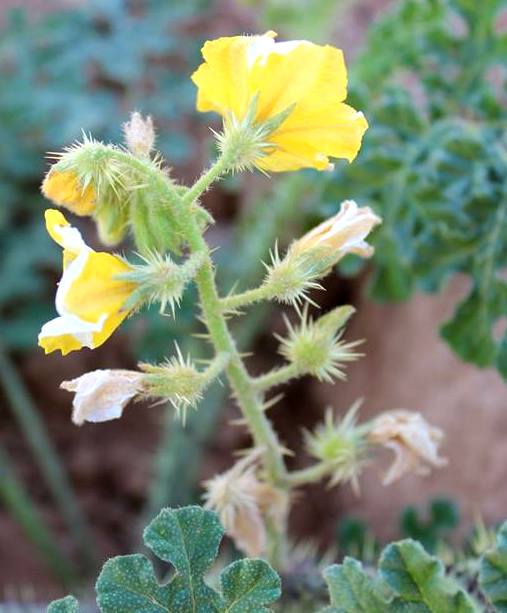 | Figure 2. Inflourescnece |
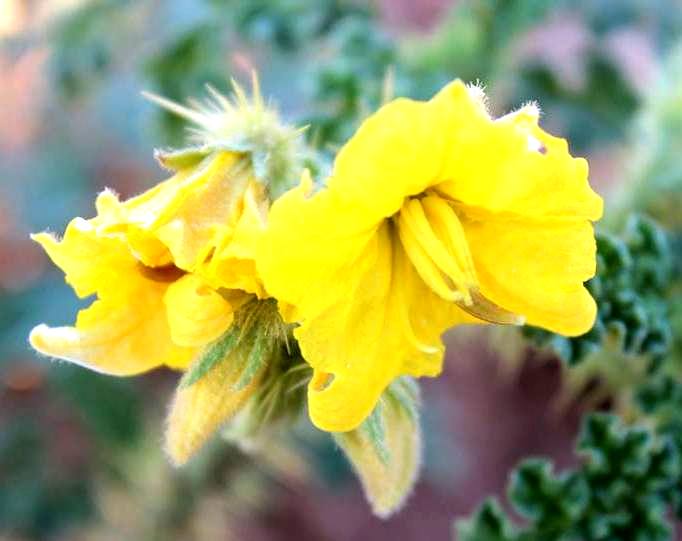 | Figure 3. Flower showing larger and curved stamen |
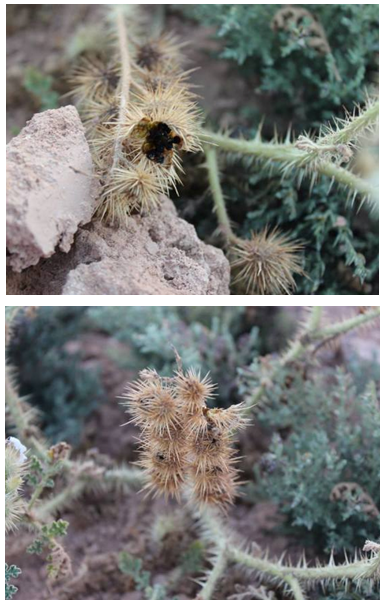 | Figure 4. Right (Closed fruits), Left (Dehiscent fruis) |
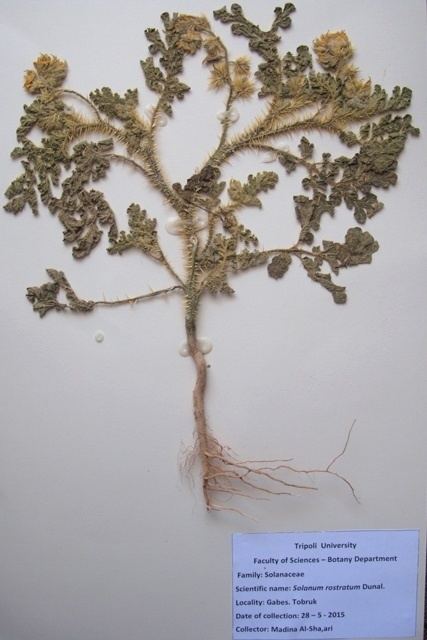 | Figure 5. Herbarium specimen |
3. Results and Discussion
- The identification of this species was done using the dat from the literature [2, 5, 8-16].In addition, it is easily recognized by its yellow showy rotate flowers, longer curved fifth stamen, long yellow sharp prickles, and stellate hairs.
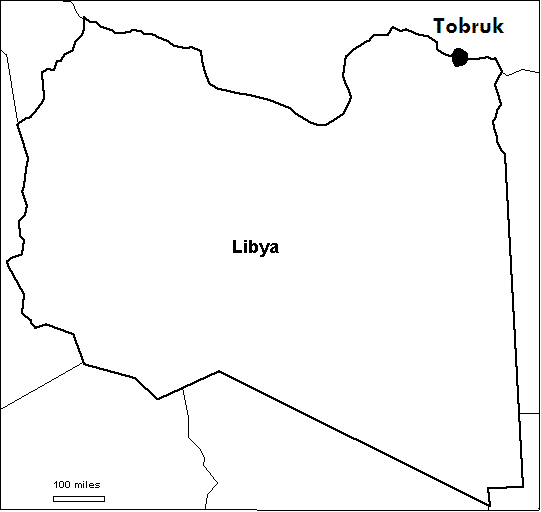 | Figure 6. A map of libya showing locality |
ACKNOWLEDGMENTS
- I would like to express my sincere gratitude to Ms Madina Al-shaari from Tubrk who collect the plant specimens, sent me and took photographs at the collection sites.
 Abstract
Abstract Reference
Reference Full-Text PDF
Full-Text PDF Full-text HTML
Full-text HTML